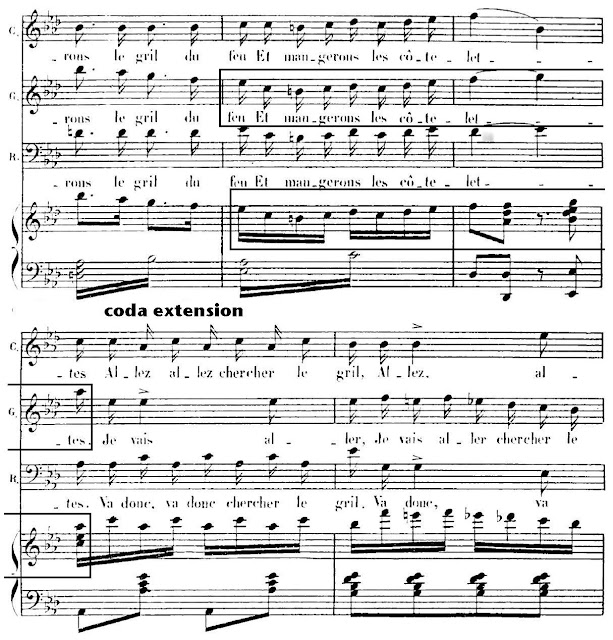In the first reprise, the frame is temporarily expanded upward to include Ab5--see the final bars of the example below--but the fifth frame is not disturbed.
In the final reprise, on the other hand, the frame is again expanded upward to include Ab5, firmly now thanks to Gustave's final note. (In Neumeyer 2009, I call this device ADDINV; here the result is a tonal frame of three pitches, Ab4-Eb5-Ab5, after the fifth is inverted and its fourth added on top.) The change happens quite directly, as you can see, without the inclusion of a line -- see the reprise below -- and a proto-background is the most musically satisfying large-scale figure for the number.
Number 4 is a trio about cooking dinner: "Va donc, chercher le gril!" (in the operetta's Scene 7). A traditional multi-section form, the trio begins with an Allegro vivo for all three singers. "Mais, que ferez-vous de ce gril?" follows, a brief scena/recit between Gustave and Catherine. "Nous mettrons le gril sur le feu" is much longer, beginning as a Moderato 16-bar period (between Rabastens and Catherine), after that a contrasting B-section for Catherine and Gustave, who then repeat the 16-bar period, but—as the example below indicates—without completing it, as Catherine gives comic emphasis to "grilled lamb chops." The presto coda that follows is the point of interest here. It consists of an eight-bar theme (period) that is repeated (plus a short orchestral codetta). Both statements of the theme include a rising line in the cadence -- these are boxed in the score below. Gustave sings the figure the first time, then all three offer it in the high-spirited finish.
As it happens, the presto may have the expressive effect of a coda, but in form-functional terms it is not a coda. William Caplin distinguishes between expansion and extension: essentially, the former happens within a theme, the latter after the theme's cadence. Codas are properly extensions, "added on" after the structural cadence. But in this case the presto expands the consequent of the 16-bar theme and only then provides the structural cadence itself.
To show how this works, here is the initial presentation of "Nous mettrons le gril sur le feu." Note that the closing cadence is to the dominant -- and coincidentally features an internal rising line as well.
Here is an abbreviated scheme that shows the design of the reprise consequent + presto first phrase.
The structural cadence, of course, happens on the repetition of the presto's 8-bar theme:









